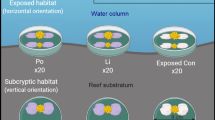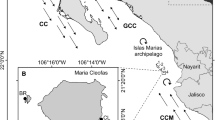Abstract
Extremely low post-settlement survival is one of the largest barriers for artificial rehabilitation of Acropora corals. However, little data have been found for interspecific difference of the post-settlement survival probably because the observation of coral juvenile is difficult in the field. Here, we analyzed the survival of three dominant species of Acropora corals (A. digitifera, A. tenuis, A. yongei), with different colony morphologies and habitat preferences, for 2 years after settlement under the same environmental conditions. The post-settlement survival was significantly higher for A. tenuis than for A. digitifera 3 months after settlement. Two years later, the survival rate of A. tenuis was approximately 15 times higher than A. digitifera. In a separate analysis of three bottle-brush species (A. awi, A. echinata, A. subglabra) and A. tenuis, post-settlement survival was always higher for A. awi than for other two bottle-brush species, suggesting that the initial survival was different among morphologically sister species. Low survival was possibly associated with slow growth rates during the first 7 months. Thus, species selection is important for successful artificial coral rehabilitation, with A. tenuis being the most viable option. Alternatively, new techniques are required to improve post-settlement survival of slow growing coral species.





Similar content being viewed by others
References
Alvarez-Filip L, Dulvy NK, Gill JA, Côté IM, Watkinson AR (2009) Flattening of Caribbean coral reefs: region-wide declines in architectural complexity. Proc R Soc B 276:3019–3025
Baria MVB, Guest JR, Edwards AJ, Aliñoa PM, Heyward AJ, Gomez ED (2010) Caging enhances post-settlement survival of juveniles of the scleractinian coral Acropora tenuis. J Exp Mar Biol Ecol 394:149–153
Bellwood DR, Hughes TP, Folke C, Nyström M (2004) Confronting the coral reef crisis. Nature 429:827–833
Death G, Fabricius KE, Sweatman H, Puotinen M (2012) The 27-year decline of coral cover on the Great Barrier Reef and its causes. Proc Natl Acad Sci USA 109:17995–17999
dela Cruz DW, Harrison PL (2017) Enhanced larval supply and recruitment can replenish reef corals on degraded reefs. Sci Rep 7:13985
Edwards AJ, Guest JR, Heyward AJ, Villanueva RD, Baria MV, Bollozos ISF, Golbuu Y (2015) Direct seeding of mass-cultured coral larvae is not an effective option for reef rehabilitation. Mar Ecol Prog Ser 525:105–116
Fukami H, Omori M, Shimoike K, Hayashibara T, Hatta M (2003) Ecological and genetic aspects of reproductive isolation by different spawning times in Acropora corals. Mar Biol 142:679–684
Harii S, Nadaoka K, Yamamoto M, Iwao K (2007) Temporal changes in settlement, lipid content and lipid composition of larvae of the spawning hermatypic coral Acropora tenuis. Mar Ecol Prog Ser 346:89–96
Harrison PL, Wallace CC (1990) Reproduction, dispersal and recruitment of scleractinian corals. In: Dubinsky Z (ed) Ecosystems of the world 25. Coral reefs. Elsevier, Amsterdam, pp 133–207
Hayashibara T, Iwao K, Omori M (2004) Induction and control of spawning in Okinawan staghorn corals. Coral Reefs 23:406–409
Heyward AJ, Smith LD, Rees M, Field SN (2002) Enhancement of coral recruitment by in situ mass culture of coral larvae. Mar Ecol Prog Ser 230:113–118
Hsieh HJ, Chen KS, Lin YI, Huang YA, Baird AH, Tsai WA, Su WC, Chen CA (2011) Establishment of a no-take area (NTA) could not guarantee the preservation of coral communities in Chinwan Inner Bay, Penghu, Taiwan. Zool Stud 50:443–453
Loya Y, Sakai K, Yamazato K, Nakano Y, Sambali H, van Woesik R (2001) Coral bleaching: the winners and the losers. Ecol Lett 4:122–131
May RC (1974) Larval mortality in marine fishes and the critical period concept. In: Blaxter JHS (ed) The early life history of fish. Springer Science & Business Media, Berlin, pp 3–19
Nakamura R, Ando W, Yamamoto H, Kitano M, Sato A, Nakamura M, Kayanne H, Omori M (2011) Corals mass-cultured from eggs and transplanted as juveniles to their native, remote coral reef. Mar Ecol Prog Ser 436:161–168
Nanami A, Sato T, Takebe T, Teruya K, Soyano K (2013) Microhabitat association in white-streaked grouper Epinephelus ongus: importance of Acropora spp. Mar Biol 160:1511–1517
Nishikawa A, Katoh M, Sakai K (2003) Larval settlement rates and gene flow of broadcast-spawning (Acropora tenuis) and planula-brooding (Stylophora pistillata) corals. Mar Ecol Prog Ser 256:87–97
Nozawa Y (2008) Micro-crevice structure enhances coral spat survivorship. J Exp Mar Biol Ecol 367:127–130
Omori M (2011) Degradation and restoration of coral reefs: experience in Okinawa, Japan. Mar Biol Res 7:3–12
Omori M, Iwao K, Tamura M (2008) Growth of transplanted Acropora tenuis 2 years after egg culture. Coral Reefs 27:165
Penin L, Michonneau F, Baird AH, Connolly SR, Pratchett MS, Kayal M, Adjeroud M (2010) Early post-settlement mortality and the structure of coral assemblages. Mar Ecol Prog Ser 408:55–64
Pratchett MS (2007) Feeding preferences of Acanthaster planci (Echinodermata: Asteroidea) under controlled conditions of food availability. Pacif Sci 61:113–120
Pratchett MS, Schenk TJ, Baine M, Syms C, Baird AH (2009) Selective coral mortality associated with outbreaks of Acanthaster planci L. in Bootless Bay, Papua New Guinea. Mar Environ Res 67:230–236
Price PW (1974) Strategies for egg production. Evolution 28:76–84
Shafir S, Van Rijn J, Rinkevich B (2006) Steps in the construction of underwater coral nursery, an essential component in reef restoration acts. Mar Biol 149:679–687
Suzuki G, Kai S, Yamashita H, Suzuki K, Iehisa Y, Hayashibara T (2011) Narrower grid structure of artificial reef enhances initial survival of in situ settled coral. Mar Pollut Bull 62:2803–2812
Suzuki G, Arakaki S, Suzuki K, Iehisa Y, Hayashibara T (2012a) What is the optimal density of larval seeding in Acropora corals? Fish Sci 78:801–808
Suzuki G, Arakaki S, Kai S, Hayashibara T (2012b) Habitat differentiation in the early life stage of simultaneously mass-spawning corals. Coral Reefs 31:535–545
Suzuki G, Yamashita H, Kai S, Hayashibara T, Suzuki K, Iehisa Y, Okada W, Ando W, Komori T (2013) Early uptake of specific symbionts enhances the post-settlement survival of Acropora corals. Mar Ecol Prog Ser 494:149–158
Underwood AJ, Fairweather PG (1989) Supply-side ecology and benthic marine assemblages. Trends Ecol Evol 4:16–20
van Oppen M, Catmull J, McDonald B, Hislop NR, Hagerman PJ, Miller DJ (2002) The mitochondrial genome of Acropora tenuis (Cnidaria; Scleractinia) contains a large group I intron and a candidate control region. J Mol Evol 55:1–13
van Oppen MJH, Gates RD, Blackall LL, Cantin N, Chakravarti LJ, Chan WY, Cormick C, Crean A, Damjanovic K, Epstein H, Harrison PL, Jones TA, Miller M, Pears RJ, Peplow LM, Raftos DA, Schaffelke B, Stewart K, Torda G, Wachenfeld D, Weeks AR, Putnam HM (2017) Shifting paradigms in restoration of the world’s coral reefs. Glob Change Biol 23:3437–3448
Victor C (1986) Larval settlement and juvenile mortality in a recruitment-limited coral reef fish population. Ecol Monogr 56:145–160
Wallace CC (1999) Staghorn corals of the world: a revision of the coral genus Acropora. CSIRO Publishing, Collingwood
Young CN, Schopmeyer SA, Lirman D (2012) A review of reef restoration and coral propagation using the threatened genus Acropora in the Caribbean and Western Atlantic. Bull Mar Sci 88:1075–1098
Acknowledgements
This study formed part of the Coral Propagation under Severe Environmental Conditions project of the Fisheries Agency, Japan, and was partly supported by a JSPS KAKENHI Grant (15H04538 for GS). The sampling of corals was permitted by the Okinawa Prefectural Government for research purposes (no. 24-54 and 27-73).
Author information
Authors and Affiliations
Corresponding author
Rights and permissions
About this article
Cite this article
Suzuki, G., Okada, W., Yasutake, Y. et al. Interspecific differences in the post-settlement survival of Acropora corals under a common garden experiment. Fish Sci 84, 849–856 (2018). https://doi.org/10.1007/s12562-018-1230-5
Received:
Accepted:
Published:
Issue Date:
DOI: https://doi.org/10.1007/s12562-018-1230-5




